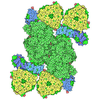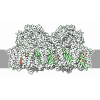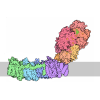[English] 日本語
 Yorodumi
Yorodumi- PDB-6trd: Cryo- EM structure of the Thermosynechococcus elongatus photosyst... -
+ Open data
Open data
- Basic information
Basic information
| Entry | Database: PDB / ID: 6trd | |||||||||||||||||||||
|---|---|---|---|---|---|---|---|---|---|---|---|---|---|---|---|---|---|---|---|---|---|---|
| Title | Cryo- EM structure of the Thermosynechococcus elongatus photosystem I in the presence of cytochrome c6 | |||||||||||||||||||||
 Components Components | (Photosystem I ...) x 12 | |||||||||||||||||||||
 Keywords Keywords | PHOTOSYNTHESIS / Photosystem I / P700 / Cyanobacteria | |||||||||||||||||||||
| Function / homology |  Function and homology information Function and homology informationphotosystem I reaction center / photosystem I / photosynthetic electron transport in photosystem I / photosystem I / chlorophyll binding / plasma membrane-derived thylakoid membrane / photosynthesis / 4 iron, 4 sulfur cluster binding / electron transfer activity / oxidoreductase activity ...photosystem I reaction center / photosystem I / photosynthetic electron transport in photosystem I / photosystem I / chlorophyll binding / plasma membrane-derived thylakoid membrane / photosynthesis / 4 iron, 4 sulfur cluster binding / electron transfer activity / oxidoreductase activity / magnesium ion binding / metal ion binding / membrane Similarity search - Function | |||||||||||||||||||||
| Biological species |   Thermosynechococcus elongatus BP-1 (bacteria) Thermosynechococcus elongatus BP-1 (bacteria) | |||||||||||||||||||||
| Method | ELECTRON MICROSCOPY / single particle reconstruction / cryo EM / Resolution: 3.16 Å | |||||||||||||||||||||
 Authors Authors | Koelsch, A. / Radon, C. / Baumert, A. / Buerger, J. / Mielke, T. / Lisdat, F. / Zouni, A. / Wendler, P. | |||||||||||||||||||||
| Funding support |  Germany, 3items Germany, 3items
| |||||||||||||||||||||
 Citation Citation |  Journal: Curr.Opin.Struct.Biol. / Year: 2020 Journal: Curr.Opin.Struct.Biol. / Year: 2020Title: Current limits of structural biology: The transient interaction between cytochrome c6 and photosystem I Authors: Koelsch, A. / Radon, C. / Golub, M. / Baumert, A. / Burger, J. / Miehlke, T. / Lisdat, F. / Feoktystov, A. / Pieper, J. / Zouni, A. / Wendler, P. | |||||||||||||||||||||
| History |
|
- Structure visualization
Structure visualization
| Movie |
 Movie viewer Movie viewer |
|---|---|
| Structure viewer | Molecule:  Molmil Molmil Jmol/JSmol Jmol/JSmol |
- Downloads & links
Downloads & links
- Download
Download
| PDBx/mmCIF format |  6trd.cif.gz 6trd.cif.gz | 1.6 MB | Display |  PDBx/mmCIF format PDBx/mmCIF format |
|---|---|---|---|---|
| PDB format |  pdb6trd.ent.gz pdb6trd.ent.gz | 1.4 MB | Display |  PDB format PDB format |
| PDBx/mmJSON format |  6trd.json.gz 6trd.json.gz | Tree view |  PDBx/mmJSON format PDBx/mmJSON format | |
| Others |  Other downloads Other downloads |
-Validation report
| Summary document |  6trd_validation.pdf.gz 6trd_validation.pdf.gz | 21.9 MB | Display |  wwPDB validaton report wwPDB validaton report |
|---|---|---|---|---|
| Full document |  6trd_full_validation.pdf.gz 6trd_full_validation.pdf.gz | 22.9 MB | Display | |
| Data in XML |  6trd_validation.xml.gz 6trd_validation.xml.gz | 267.7 KB | Display | |
| Data in CIF |  6trd_validation.cif.gz 6trd_validation.cif.gz | 339.3 KB | Display | |
| Arichive directory |  https://data.pdbj.org/pub/pdb/validation_reports/tr/6trd https://data.pdbj.org/pub/pdb/validation_reports/tr/6trd ftp://data.pdbj.org/pub/pdb/validation_reports/tr/6trd ftp://data.pdbj.org/pub/pdb/validation_reports/tr/6trd | HTTPS FTP |
-Related structure data
| Related structure data |  10559MC  6traC  6trcC M: map data used to model this data C: citing same article ( |
|---|---|
| Similar structure data |
- Links
Links
- Assembly
Assembly
| Deposited unit | 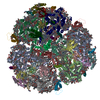
|
|---|---|
| 1 |
|
- Components
Components
-Photosystem I ... , 12 types, 36 molecules Aa1Bb2Cc3Dd4Ee5Ff6Ii7Jj8Kk9Ll0...
| #1: Protein | Mass: 83267.773 Da / Num. of mol.: 3 / Source method: isolated from a natural source Source: (natural)   Thermosynechococcus elongatus BP-1 (bacteria) Thermosynechococcus elongatus BP-1 (bacteria)References: UniProt: P0A405, photosystem I #2: Protein | Mass: 83123.648 Da / Num. of mol.: 3 / Source method: isolated from a natural source Source: (natural)   Thermosynechococcus elongatus BP-1 (bacteria) Thermosynechococcus elongatus BP-1 (bacteria)References: UniProt: P0A407, photosystem I #3: Protein | Mass: 8809.207 Da / Num. of mol.: 3 / Source method: isolated from a natural source Source: (natural)   Thermosynechococcus elongatus BP-1 (bacteria) Thermosynechococcus elongatus BP-1 (bacteria)References: UniProt: P0A415, photosystem I #4: Protein | Mass: 15389.494 Da / Num. of mol.: 3 / Source method: isolated from a natural source Source: (natural)   Thermosynechococcus elongatus BP-1 (bacteria) Thermosynechococcus elongatus BP-1 (bacteria)References: UniProt: P0A420 #5: Protein | Mass: 8399.485 Da / Num. of mol.: 3 / Source method: isolated from a natural source Source: (natural)   Thermosynechococcus elongatus BP-1 (bacteria) Thermosynechococcus elongatus BP-1 (bacteria)References: UniProt: P0A423 #6: Protein | Mass: 15129.358 Da / Num. of mol.: 3 / Source method: isolated from a natural source Source: (natural)   Thermosynechococcus elongatus BP-1 (bacteria) Thermosynechococcus elongatus BP-1 (bacteria)References: UniProt: P0A401 #7: Protein/peptide | Mass: 4325.245 Da / Num. of mol.: 3 / Source method: isolated from a natural source Source: (natural)   Thermosynechococcus elongatus BP-1 (bacteria) Thermosynechococcus elongatus BP-1 (bacteria)References: UniProt: P0A427 #8: Protein/peptide | Mass: 4798.708 Da / Num. of mol.: 3 / Source method: isolated from a natural source Source: (natural)   Thermosynechococcus elongatus BP-1 (bacteria) Thermosynechococcus elongatus BP-1 (bacteria)References: UniProt: P0A429 #9: Protein | Mass: 8483.983 Da / Num. of mol.: 3 / Source method: isolated from a natural source Source: (natural)   Thermosynechococcus elongatus BP-1 (bacteria) Thermosynechococcus elongatus BP-1 (bacteria)References: UniProt: P0A425 #10: Protein | Mass: 16287.765 Da / Num. of mol.: 3 / Source method: isolated from a natural source Source: (natural)   Thermosynechococcus elongatus BP-1 (bacteria) Thermosynechococcus elongatus BP-1 (bacteria)References: UniProt: Q8DGB4 #11: Protein/peptide | Mass: 3426.115 Da / Num. of mol.: 3 / Source method: isolated from a natural source Source: (natural)   Thermosynechococcus elongatus BP-1 (bacteria) Thermosynechococcus elongatus BP-1 (bacteria)References: UniProt: P0A403 #12: Protein/peptide | Mass: 4104.939 Da / Num. of mol.: 3 / Source method: isolated from a natural source Source: (natural)   Thermosynechococcus elongatus BP-1 (bacteria) Thermosynechococcus elongatus BP-1 (bacteria)References: UniProt: Q8DKP6 |
|---|
-Non-polymers , 9 types, 453 molecules 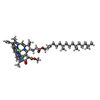
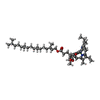
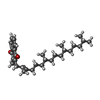
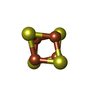
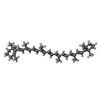
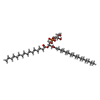

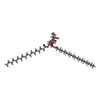









| #13: Chemical | | #14: Chemical | ChemComp-CLA / #15: Chemical | ChemComp-PQN / #16: Chemical | ChemComp-SF4 / #17: Chemical | ChemComp-BCR / #18: Chemical | ChemComp-LHG / #19: Chemical | ChemComp-CA / #20: Chemical | #21: Water | ChemComp-HOH / | |
|---|
-Details
| Has ligand of interest | N |
|---|---|
| Has protein modification | Y |
-Experimental details
-Experiment
| Experiment | Method: ELECTRON MICROSCOPY |
|---|---|
| EM experiment | Aggregation state: PARTICLE / 3D reconstruction method: single particle reconstruction |
- Sample preparation
Sample preparation
| Component | Name: photosystem I / Type: COMPLEX / Entity ID: #1-#12 / Source: NATURAL | ||||||||||||||||||||
|---|---|---|---|---|---|---|---|---|---|---|---|---|---|---|---|---|---|---|---|---|---|
| Molecular weight | Value: 1 MDa / Experimental value: NO | ||||||||||||||||||||
| Source (natural) | Organism:   Thermosynechococcus elongatus BP-1 (bacteria) Thermosynechococcus elongatus BP-1 (bacteria) | ||||||||||||||||||||
| Buffer solution | pH: 8 | ||||||||||||||||||||
| Buffer component |
| ||||||||||||||||||||
| Specimen | Conc.: 0.2 mg/ml / Embedding applied: NO / Shadowing applied: NO / Staining applied: NO / Vitrification applied: YES Details: Photosystem I was crosslinked with its electron donor cytochrome c6. Crosslinked particles are monodisperse. | ||||||||||||||||||||
| Vitrification | Cryogen name: ETHANE |
- Electron microscopy imaging
Electron microscopy imaging
| Experimental equipment |  Model: Tecnai Polara / Image courtesy: FEI Company |
|---|---|
| Microscopy | Model: FEI POLARA 300 |
| Electron gun | Electron source:  FIELD EMISSION GUN / Accelerating voltage: 300 kV / Illumination mode: FLOOD BEAM FIELD EMISSION GUN / Accelerating voltage: 300 kV / Illumination mode: FLOOD BEAM |
| Electron lens | Mode: BRIGHT FIELD |
| Specimen holder | Cryogen: NITROGEN |
| Image recording | Electron dose: 32 e/Å2 / Detector mode: SUPER-RESOLUTION / Film or detector model: GATAN K2 SUMMIT (4k x 4k) |
- Processing
Processing
| EM software |
| ||||||||||||||||||||||||||||
|---|---|---|---|---|---|---|---|---|---|---|---|---|---|---|---|---|---|---|---|---|---|---|---|---|---|---|---|---|---|
| CTF correction | Details: CTFFIND4 was used to estimate contrast transfer function parameters. CTF correction was done in Relion 3.0. Type: PHASE FLIPPING AND AMPLITUDE CORRECTION | ||||||||||||||||||||||||||||
| Symmetry | Point symmetry: C1 (asymmetric) | ||||||||||||||||||||||||||||
| 3D reconstruction | Resolution: 3.16 Å / Resolution method: FSC 0.143 CUT-OFF / Num. of particles: 175999 / Symmetry type: POINT | ||||||||||||||||||||||||||||
| Atomic model building | Protocol: RIGID BODY FIT / Space: REAL | ||||||||||||||||||||||||||||
| Atomic model building | PDB-ID: 1JB0 Accession code: 1JB0 / Source name: PDB / Type: experimental model |
 Movie
Movie Controller
Controller




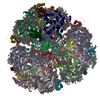
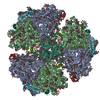
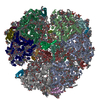
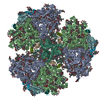
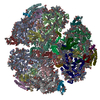
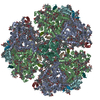
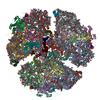
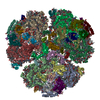
 PDBj
PDBj

